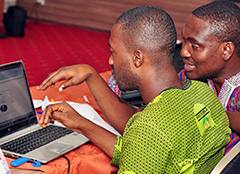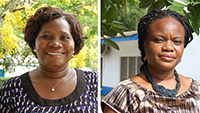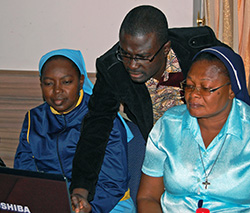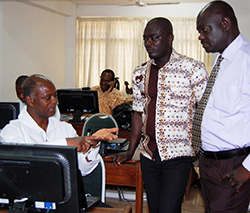
iHRIS Champions in Ghana Share Success with Using Health Workforce Data
 Like many of his fellow Ghanaians, Obeng Asomaning wanted to use his skills to help his country. As a new graduate with a degree in health service planning and management, he landed a job at the Ministry of Health’s Regional Health Office in Ashanti Region. Quickly he saw that the office was struggling to access information about the health workforce. How many midwives worked in the regional hospital? How many vacancies were there in Kwabre District? How many health workers will likely retire next year? The paper-based information system yielded no quick answers.
Like many of his fellow Ghanaians, Obeng Asomaning wanted to use his skills to help his country. As a new graduate with a degree in health service planning and management, he landed a job at the Ministry of Health’s Regional Health Office in Ashanti Region. Quickly he saw that the office was struggling to access information about the health workforce. How many midwives worked in the regional hospital? How many vacancies were there in Kwabre District? How many health workers will likely retire next year? The paper-based information system yielded no quick answers.
Answers to these kinds of questions are important because the country has a critical shortage of health workers. There are only 13.6 health workers for every 10,000 people, well below the minimum recommended threshold of 22.8 health workers per 10,000 population. To improve the population’s health outcomes, Ghana needs to make the most of the health workforce it currently has while working to increase their numbers. Obeng teamed up with Molayo Decker, an IT officer, to pilot iHRIS in Northern Region. iHRIS is a free, open source software suite used in 19 countries to track, manage, and plan the health workforce.
Obeng teamed up with Molayo Decker, an IT officer, to pilot iHRIS in Northern Region. iHRIS is a free, open source software suite used in 19 countries to track, manage, and plan the health workforce.
Realizing the value of the software, the Ministry of Health decided to roll it out nationally. Obeng and Molayo worked with Ghana Health Service, the largest national health provider, to enter information on 14,000 health workers into iHRIS. And they helped the country’s largest faith-based organization, the Christian Health Association of Ghana (CHAG), to implement iHRIS in its health facilities. So far CHAG has entered data on 4,500 health workers into the system and has committed to rolling out iHRIS in all of its 183 facilities.  Now others have joined Obeng and Molayo as “iHRIS champions” to train users and decision-makers on using the iHRIS software for health workforce planning and management. Dr. Linda Vanotoo, director of Greater Accra Region in Ghana Health Service, and Elsie Okoh, former regional manager of Greater Accra Region, collaborated with Obeng to facilitate iHRIS training on their own a few months ago. CHAG has also facilitated its own training.
Now others have joined Obeng and Molayo as “iHRIS champions” to train users and decision-makers on using the iHRIS software for health workforce planning and management. Dr. Linda Vanotoo, director of Greater Accra Region in Ghana Health Service, and Elsie Okoh, former regional manager of Greater Accra Region, collaborated with Obeng to facilitate iHRIS training on their own a few months ago. CHAG has also facilitated its own training.
Here’s what the iHRIS champions are saying.
Data use is key
“We don’t just use data in a vacuum,” Elsie points out. During the training, she and her colleagues used practical methods so the participants could use the real data from iHRIS to master the concept of making evidence-based decisions. Francis Kyereboah, HR planning officer at CHAG, says “we teach the facility managers how to analyze the data. For example, we show them how to generate reports on retirement planning and then use the data in those reports to better plan for the future.”
Francis Kyereboah, HR planning officer at CHAG, says “we teach the facility managers how to analyze the data. For example, we show them how to generate reports on retirement planning and then use the data in those reports to better plan for the future.”
CHAG has 21 church health coordinating units that each take responsibility for the CHAG health facilities under its jurisdiction. They use iHRIS data for health workforce advocacy, planning, management, and forecasting. And facility managers use data to plan for staff leave, make decisions to help the facility run smoothly, and even know when to celebrate birthdays to boost staff morale.
iHRIS helps make sure health workers are posted in the areas of greatest need
Health workers are concentrated in Ghana’s capital, Accra. Obeng describes efforts to recruit new staff based on data: “With iHRIS you can even tell where the vacancies are, and then you base your advertisement on the vacancies. [That] will help to improve upon better distribution, which will have a direct impact on quality of access to health care.” CHAG staff members use iHRIS data to decide how many nurses and doctors they need to put in their facilities. “The system allows us to see the details so we know how many health workers are actually working on the ground,” Francis notes. “This level of detail helps us to make equitable recruitment and promotion decisions.“
CHAG staff members use iHRIS data to decide how many nurses and doctors they need to put in their facilities. “The system allows us to see the details so we know how many health workers are actually working on the ground,” Francis notes. “This level of detail helps us to make equitable recruitment and promotion decisions.“
“You’re able to know many staffs are needed in a particular place and how many are supposed to be promoted, how many have had training,” says Dr. Ebenezer Appiah-Denkyira, director general of Ghana Health Service. “Whatever information that we want concerning personnel management and development, you can get from iHRIS.”
iHRIS links to other health information systems and platforms
The Ministry of Health and Ghana Health Service are working to link iHRIS with the District Health Information Management System 2.0 (DHMIS 2), based on the DHIS 2 software. Routine reporting from iHRIS of the number of health workers by cadre in each facility allows this information to be tied to service delivery statistics. Molayo articulates the benefit of this linkage: “If we take any professional working in a facility, you can actually know the impact they are having.”
iHRIS provides a full picture by connecting the public, private, and faith-based sectors
Ghana’s iHRIS currently has 18,500 health worker records, but the iHRIS champions don’t plan to stop there.
The Ministry of Health, Ghana Health Service, CHAG, and some teaching hospitals have teamed up to provide training and technical assistance to support one another. The organizations are working with the Ministry to write a proposal requesting additional support to roll out iHRIS. The leaders envision bringing the private sector on board and adding mapping capabilities. Molayo explains, “We want to create a map with the GIS system that shows how many nurses we have here, how many doctors we have here. The politician or the director doesn't have time to go through whole pages of information. He wants to see.”
The iHRIS champions recognize that as the number of health worker records increases, the stronger the power of the data and the more complete the picture of the health workforce will be.
 IntraHealth International, through the USAID-funded Capacity Project, launched the first version of iHRIS in 2007. CapacityPlus continues to develop the core iHRIS software, release updates, and partner with countries to roll out the software and train people to use and maintain it.
IntraHealth International, through the USAID-funded Capacity Project, launched the first version of iHRIS in 2007. CapacityPlus continues to develop the core iHRIS software, release updates, and partner with countries to roll out the software and train people to use and maintain it.
Help CapacityPlus spread the word about strengthening the health workforce. Follow us on Twitter and like us on Facebook.
Related items:
Photo 1 courtesy of Gracey Vaughn. Photo 2 by Carol Bales (Obeng Asomaning offers one-on-one guidance as a training participant from CHAG learns how to export iHRIS data and create tables and charts that provide detailed, accurate information on the health workforce). Photos 3, 4, and 5 by Gracey Vaughn (Dr. Linda Vanotoo and Elsie Okoh, who teamed up to facilitate an iHRIS training in the region with the most health workers; Francis Kyereboah provides hands-on guidance as HR managers learn how to navigate iHRIS; Dr. Ebenezer Appiah-Denkyira participates in an iHRIS training where he urged all regional directors and managers to adopt and roll out the software).


